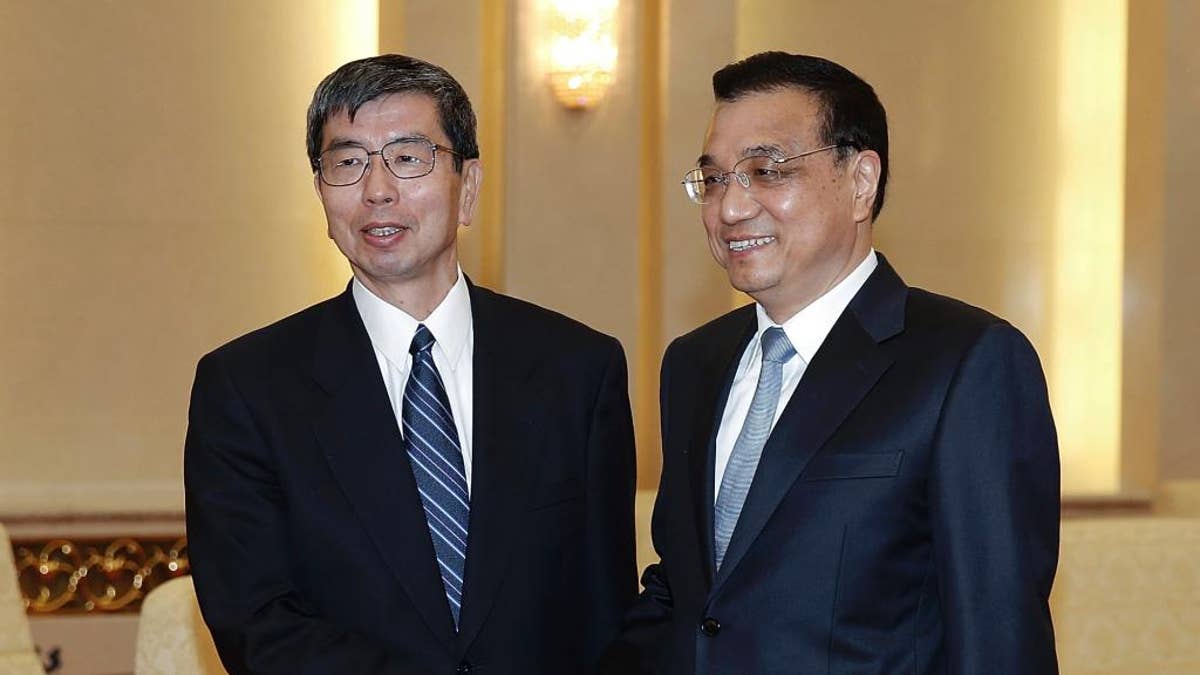
FILE - In this March 23, 2015 file photo, Asian Development Bank President Takehiko Nakao, left, poses with Chinese Premier Li Keqiang for a photo at the Great Hall of the People in Beijing. The president of the Asian Development Bank says a proposed Chinese-led regional bank is a potential partner instead of a rival and the ADB is talking with Beijing to share its experience. (AP Photo/Lintao Zhang, Pool, File) (The Associated Press)
BEIJING – The president of the Asian Development Bank says a proposed Chinese-led regional bank is a potential partner rather than a rival and the ADB is talking with Beijing to share its experience.
Takehiko Nakao's comments came after Washington softened its opposition to the Chinese-proposed Asian Infrastructure Investment Bank and suggested it work together with existing entities such the World Bank.
The Manila-based ADB is ready to collaborate with the AIIB if it meets environmental, social and other standards for lending, Nakao said in an interview ahead of Tuesday's release of his bank's regional economic outlook.
U.S. officials worry the bank might become an instrument of Chinese foreign policy and undermine the World Bank or other institutions by offering credit with few conditions.
"I think we can complement each other," Nakao said.
China proposed the bank in 2013 to finance construction of roads, ports and other infrastructure. It has pledged to put up most of its initial $50 billion in capital.
Britain broke with Washington last week to announce it wanted to join the Chinese-led bank. France, Germany and Switzerland followed.
The ADB has talked with Chinese officials to share its "knowledge and experience" based on its 50-year history and staff of some 3,000 throughout the region, said Nakao, a former deputy Japanese finance minister.
In its economic outlook, the ADB said this year's overall growth in developing Asia-Pacific countries should hold steady at last year's 6.3 percent.
China should slow to 7.2 percent from last year's 7.4 percent as the communist government tries to steer the economy to a more sustainable expansion and reduce reliance on trade and investment, the bank said. It said growth should decline further to 7 percent next year.
Growth in India, the region's other economic giant, should accelerate to 7.8 percent from last year's 7.4 percent following regulatory changes aimed at removing "structural bottlenecks," the bank said. It said that should rise further to 8.2 percent next year.
The ADB says developing Asia-Pacific economies need some $7 trillion in investment in roads, ports and other infrastructure in the decade through 2020.
On Sunday, The Wall Street Journal cited a U.S. Treasury official as proposing that the new bank work in partnership with Washington-backed development institutions such as the World Bank.
"The U.S. would welcome new multilateral institutions that strengthen the international financial architecture," the official, Nathan Sheets, was quoted as saying.
On Saturday, Chinese Finance Minister Lou Jiwei tried to ease foreign concern, saying the AIIB would complement institutions such as the World Bank and enable Beijing to shoulder more responsibility for development.
Meanwhile, the ADB plans to step up its lending to as much as $18 billion a year from the current $13 billion.
Nakao said plans call for increasing credit for the poorest countries, such as Cambodia and Afghanistan, by some 70 percent and lending and investing more in industries such as renewable energy.
